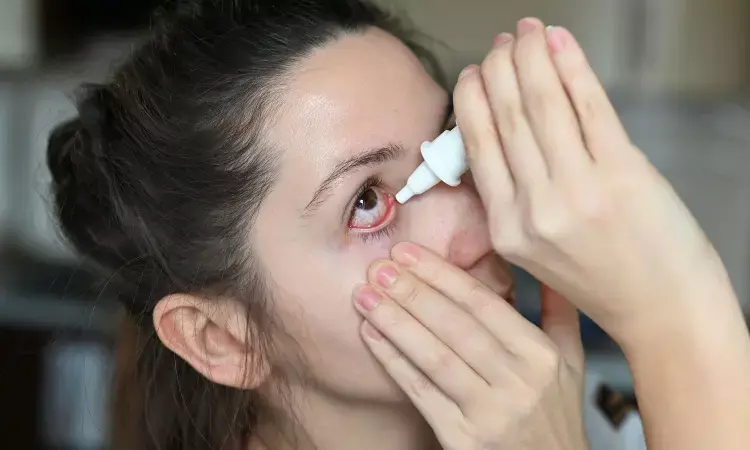- Home
- Medical news & Guidelines
- Anesthesiology
- Cardiology and CTVS
- Critical Care
- Dentistry
- Dermatology
- Diabetes and Endocrinology
- ENT
- Gastroenterology
- Medicine
- Nephrology
- Neurology
- Obstretics-Gynaecology
- Oncology
- Ophthalmology
- Orthopaedics
- Pediatrics-Neonatology
- Psychiatry
- Pulmonology
- Radiology
- Surgery
- Urology
- Laboratory Medicine
- Diet
- Nursing
- Paramedical
- Physiotherapy
- Health news
- Fact Check
- Bone Health Fact Check
- Brain Health Fact Check
- Cancer Related Fact Check
- Child Care Fact Check
- Dental and oral health fact check
- Diabetes and metabolic health fact check
- Diet and Nutrition Fact Check
- Eye and ENT Care Fact Check
- Fitness fact check
- Gut health fact check
- Heart health fact check
- Kidney health fact check
- Medical education fact check
- Men's health fact check
- Respiratory fact check
- Skin and hair care fact check
- Vaccine and Immunization fact check
- Women's health fact check
- AYUSH
- State News
- Andaman and Nicobar Islands
- Andhra Pradesh
- Arunachal Pradesh
- Assam
- Bihar
- Chandigarh
- Chattisgarh
- Dadra and Nagar Haveli
- Daman and Diu
- Delhi
- Goa
- Gujarat
- Haryana
- Himachal Pradesh
- Jammu & Kashmir
- Jharkhand
- Karnataka
- Kerala
- Ladakh
- Lakshadweep
- Madhya Pradesh
- Maharashtra
- Manipur
- Meghalaya
- Mizoram
- Nagaland
- Odisha
- Puducherry
- Punjab
- Rajasthan
- Sikkim
- Tamil Nadu
- Telangana
- Tripura
- Uttar Pradesh
- Uttrakhand
- West Bengal
- Medical Education
- Industry
0.5% Loteprednol etabonate and 0.3% tobramycin combo safe against ocular inflammatory diseases

In a new study conducted by James Deom and peers it was shown that when utilized to treat different ocular surface inflammatory disorders found in optometric practice, loteprednol etabonate 0.5% and tobramycin 0.3% (LE/T) appears to have a good level of safety. The findings of this study were published in Clinical Ophthalmology.
In ocular surface inflammatory disorders when corticosteroid therapy is recommended and there is a risk of superficial bacterial infection, the use of a combined corticosteroid and antibiotic medication is widespread. Topical corticosteroids have well-established effectiveness in the therapy of ocular inflammation, but they also have possible side effects such as increased intraocular pressure (IOP). Loteprednol etabonate 0.5% + tobramycin 0.3% is an ocular solution that combines a topical corticosteroid (loteprednol etabonate; LE) with an aminoglycoside antibiotic (tobramycin; T). As a result, this research was planned as a retrospective record review to evaluate the real-world usage of LE/T in patients with ocular surface inflammatory diseases, with a focus on dosage regimens, IOP and other safety outcomes, and clinical illness remission.
Three optometrist offices in the USA underwent a retrospective chart review for this project. Data were gathered from cases where LE/T was used, and data were kept during the time period starting with therapy with at least one follow-up appointment (within 2 months). Patient demographics, diagnosis, LE/T dosage, pre- and post-treatment ocular symptoms and signs intraocular pressure readings, adverse event (AE) reports, visual acuity (VA), and any notes on the resolution of baseline condition were all included in the data that was abstracted. IOP changes and AEs were the main outcomes that were of interest.
The key findings of this study were:
1. Data from 87 patient charts (115 LE/T-treated eyes) were included in the 96 patient charts that were retrieved.
2. The majority of patients (83.9%) were white, and slightly over half of them were female (58.6%), with a mean age (SD) of 45.6 (19.7).
3. Conjunctival injury/corneal abrasion (25.3%), viral conjunctivitis (16.1%), keratitis (18.4%), and blepharitis/eyelid inflammation/MGD (11.5%) were common baseline conditions. One drop QID was the most typical dosage for LE/T.
4. At baseline, the mean (SD) IOP was 15.2 mm Hg, and at the initial follow-up appointment, it was 15.7 mm Hg (p = 0.2467).
5. No AEs were reported, and the mean VA did not change significantly.
6. When indicated, the majority of patients (83%) had their disease cured at the first or second follow-up appointment.
In conclusion, this retrospective case evaluation offers a clinically relevant window into the practical application of LE/T in a variety of potentially infectious inflammatory ocular surface diseases. When utilized for the treatment of different ocular surface inflammatory disorders seen in optometric therapy, LE/T seems to have a good level of safety.
Reference:
Deom, J. E., Kannarr, S., & Vollmer, P. (2022). Real-World Use of Loteprednol Etabonate 0.5%/Tobramycin 0.3% Ophthalmic Suspension for the Treatment of Ocular Surface Inflammatory Conditions. In Clinical Ophthalmology: Vol. Volume 16 (pp. 3803–3809). Informa UK Limited. https://doi.org/10.2147/opth.s389688
Neuroscience Masters graduate
Jacinthlyn Sylvia, a Neuroscience Master's graduate from Chennai has worked extensively in deciphering the neurobiology of cognition and motor control in aging. She also has spread-out exposure to Neurosurgery from her Bachelor’s. She is currently involved in active Neuro-Oncology research. She is an upcoming neuroscientist with a fiery passion for writing. Her news cover at Medical Dialogues feature recent discoveries and updates from the healthcare and biomedical research fields. She can be reached at editorial@medicaldialogues.in
Dr Kamal Kant Kohli-MBBS, DTCD- a chest specialist with more than 30 years of practice and a flair for writing clinical articles, Dr Kamal Kant Kohli joined Medical Dialogues as a Chief Editor of Medical News. Besides writing articles, as an editor, he proofreads and verifies all the medical content published on Medical Dialogues including those coming from journals, studies,medical conferences,guidelines etc. Email: drkohli@medicaldialogues.in. Contact no. 011-43720751


